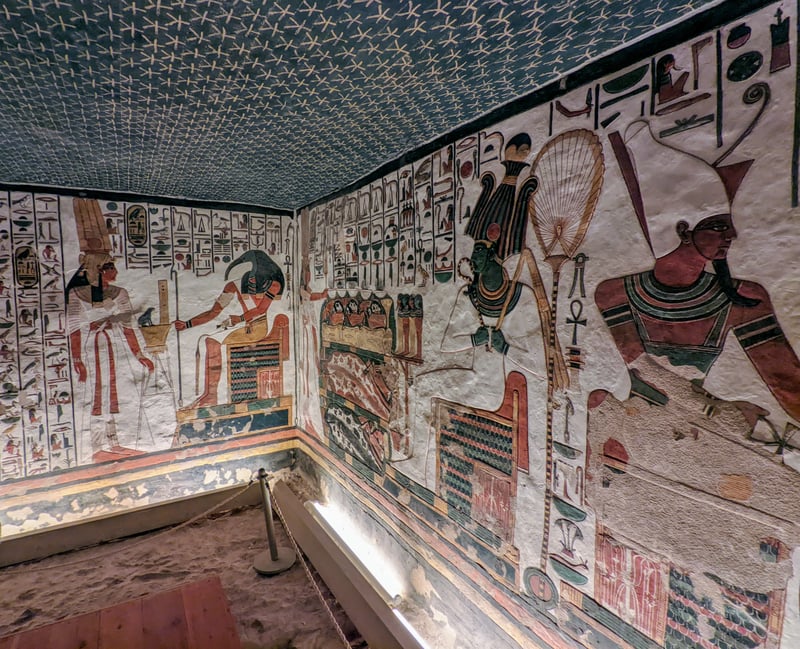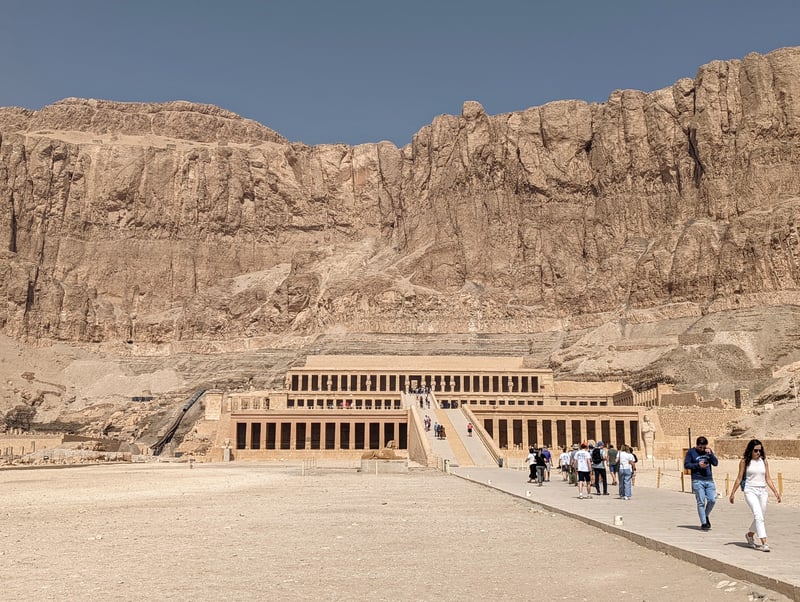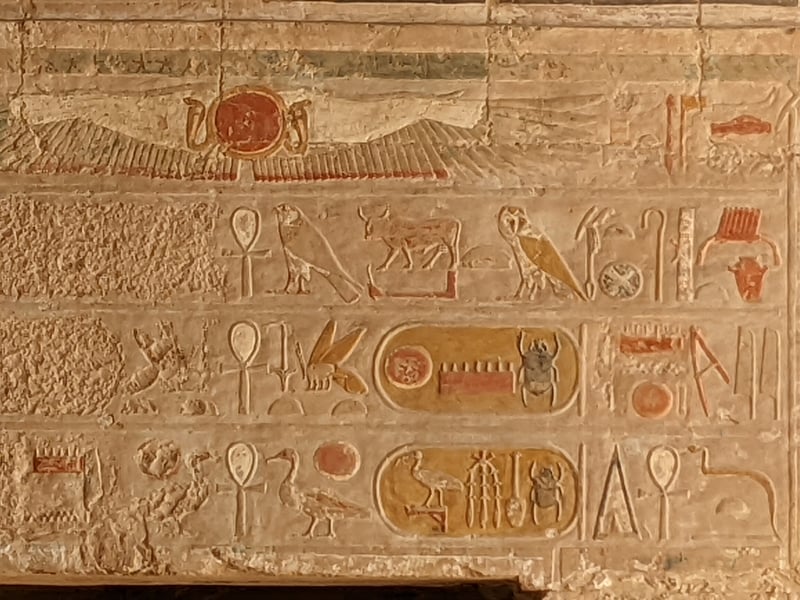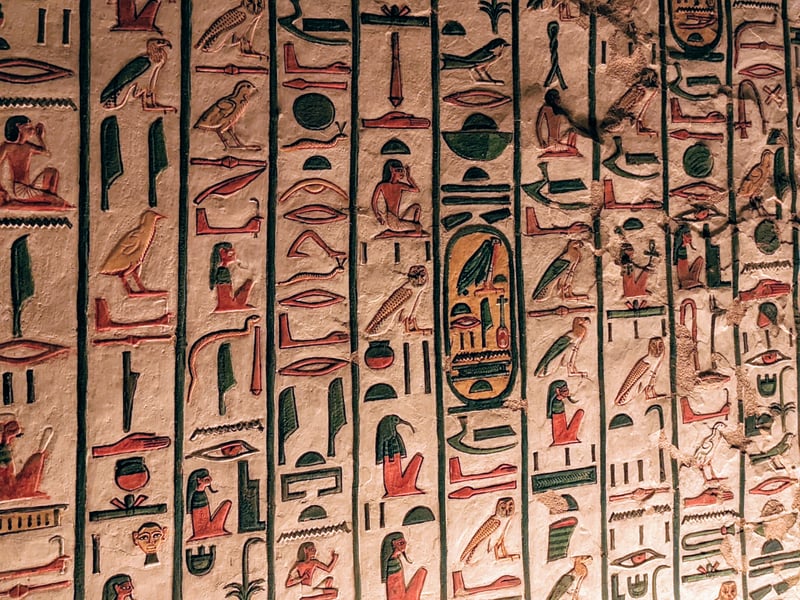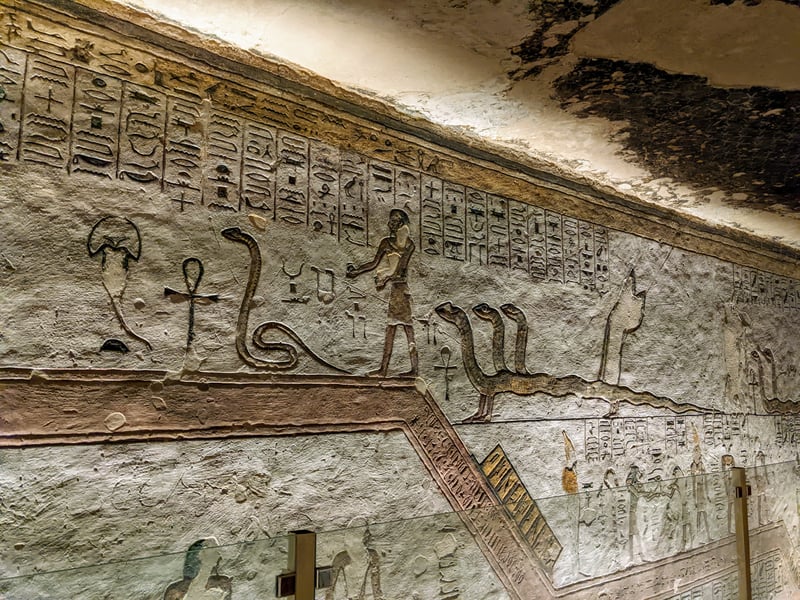Yesterday, we spent the day in transport from Cairo to Luxor via a short flight. But the traffic in Cairo is so bad, a 30 minute trip from our hotel to the airport could take up to 2 hours. Our
last blog is from Cairo, so feel free to catch up via the link. While the old kingdom's capital was Memphis, close to Cairo, the middle kingdom's capital was moved to Luxor because most of Pharaohs were from upper Egypt (southern region and at higher elevation) and they found it easier to rule from Luxor.
A view of Nefertiti's tomb, showing the stars in the sky and elaborate paintings
Nefertiti
We start the tour with the Valley of the Queens where the highlight is Queen Nefertiti's tomb. This is a fascinating tomb as it's really well preserved, showcasing colorful and tasteful artwork. It's been faithfully restored and really brings both the ancient way of life and belief system to life. Nefertiti is pictured in many different hair styles, dresses, broaches and poses. She's appears playing chess, with falcon wings and of course asking the gods for an everlasting life after death. The ceiling on the entire ceiling is covered with 5 pointed stars in a dark blue background - the night sky. All the walls including the pillars are covered in either hieroglyphics or 3D relief paintings. The tomb is not huge but elaborately and expertly decorated.
The Temple of Hatshepsut.
Note the text on the left is scratched out - these were references to Hatshepsut.
Sweet Revenge
Our next stop is at the Temple of Hatshepsut. This is a very impressive three tiered mortuary temple, a little bit in the style of the Greeks though built about 1000 years before the Greeks came to Egypt or before the Parthenon. Hatshepsut was a queen that decided to usurp power from her too young to rule stepson, the rightful heir to the throne. Instead, she portrayed herself as male, to present power to her subjects. She had a successful 21 year rein in this manner. Some very well preserved colors and reliefs can be found in one portion of the temple. Here, the full story plays out as her stepson, for revenge, scratched out all visual and written references of his mother in her own tomb.
From Rameses Tomb - close up of hieroglyphics
The ultimate old boys club
We continued by visiting the Valley of the Kings, a collection of 65 tombs of Pharaohs as well as their invited queens or children. First we visited the tomb of King Tut (Tutankhamun). We had seen the insides of the tomb in Cairo's Egypt museum a few days before. Here we were greeted first with King Tut's mummy with head and feet clearly well preserved. The actual tomb chamber was small and not well decorated because he died suddenly and the Royal artists didn't have much time to prepare the tomb. The significance of King Tut is found mainly in the original belongings found in the museum.
We then went deep into the tomb of Rameses III. This is a very well preserved corridor of color paintings and hieroglyphics. Deep blue, red and yellow colors made from grinding rock pigments can be observed everywhere. Even though we only saw part of the tomb, the decorations were both extensive and elaborate. Every wall, ceiling and floor was meticulously covered with a high level of craftsmanship. That's because if the royal architects didn't like a section, they would order it scratched out and started over. And while the royal artisans were well treated, who knows what happened to them if they made too many mistakes.
Finally we explored Rameses VI tomb. While the was much plainer, it was much steeper and contained a full sarcophagus at the bottom. There were no longer any colors left on the walls, the result of deterioration and piracy. In fact the depictions were in flat black and white, perhaps only the original sketches in the stone survive.
"Good Snakes" depicted in Rameses III tomb. The Nile is represented by the diagonal brown line. The craftsmanship is not to the same level as it was in the Nefertiti tomb, but it's much more extensive and intricate.
Hide and seek
These kings decided to try to hide their tombs. The pyramids were tombs of their ancestors and while magnificent, made it obvious where they were buried. As a result their enemies, including successors would rob the tombs. The robbers had two purposes. First, to get the magnificent treasures the Egyptians left behind for the eternal afterlife. Second was the belief that by defacing images of the pharaoh, their spirit would not be able to be reunited with the body and therefore not have an eternal afterlife, or any afterlife for that matter. Royal family feuds being what they were, revenge was a real issue. Thus, later pharaohs tried to hide their tombs. When they relocated to Luxor, they found soft limestone mountains a few miles from the Nile and decided this would be a great place to set up burial camp. Artisans were blindfolded so the wouldn't know the way to the specific tomb being prepared. And once finished the tombs would be filled with sand and made to look like the rest of the surrounding rock.
Of course the fact that all the tombs, save King Tut's was plundered and all were defaced, suggests they were not as stealthy or clever as they thought.
Final Impressions
- The amount of history we saw just today is pretty staggering.
- By scale of the royal burial tombs is also staggering. It seemed like the kingdom's wealth was gladly buried with the each succeeding pharaoh's death.
- The sophistication of the architecture (both above and below ground), artistic prowess and detailed written prayers is impressive.
